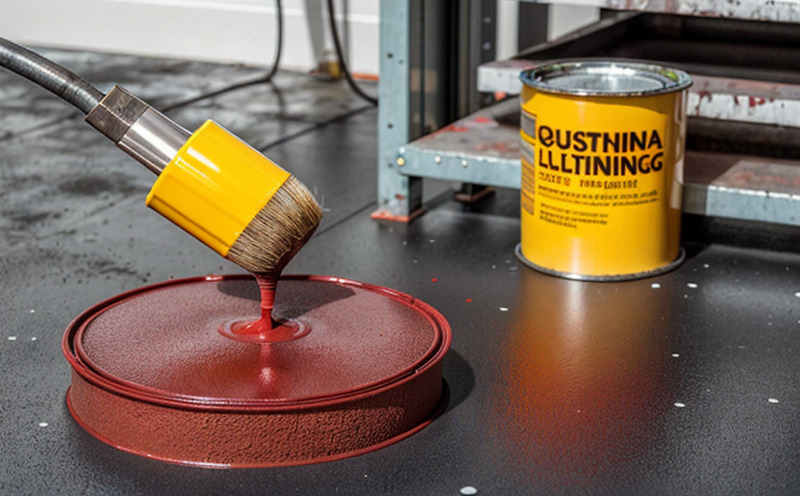ASTM D3363 Pencil Hardness Testing of Paint Films
The ASTM D3363 pencil hardness test is a widely recognized method used to evaluate the scratch resistance and durability of paint films. This test involves applying pencils of varying grades, ranging from 0H (softest) to HHH (hardest), across a painted surface to assess its resistance to scratching or abrasion.
The purpose of this test is to provide manufacturers and quality control teams with reliable data on the scratch resistance properties of paint films. By understanding these properties, companies can ensure that their products meet industry standards and customer expectations. This information is crucial for developing high-quality industrial coatings that are resistant to wear and tear in various environments.
The test procedure typically involves preparing a specimen according to ASTM D3363 guidelines. Specimens should be allowed to cure fully before testing begins, as curing time can significantly affect the results. The specimens must also be free from any defects or inconsistencies that could influence the outcome of the test.
After preparation, the pencil hardness test is conducted by drawing the chosen pencils across the surface at a 45-degree angle with moderate pressure. Multiple passes are made to ensure consistent results. The hardest pencil grade required to scratch the paint film determines its hardness rating according to ASTM D3363.
Understanding the hardness of a paint film can help in several ways, including:
- Improving product design and development
- Determining appropriate surface finishes for specific applications
- Meeting regulatory requirements and specifications
- Evaluating the effectiveness of different paint formulations
The test results provide valuable insights into how well a particular coating will perform under various conditions. For instance, in industrial manufacturing environments where surfaces are exposed to harsh conditions such as abrasion from machinery or exposure to chemicals, knowing the pencil hardness can be critical for selecting the right coatings.
It is important to note that while ASTM D3363 offers a standardized method for evaluating paint film hardness, it does not cover all aspects of coating performance. Other tests may need to complement this one depending on specific application requirements.
In summary, the ASTM D3363 pencil hardness test is an essential tool in industrial manufacturing and processing testing, particularly when assessing the scratch resistance of paint films. Its importance lies in providing consistent data that can guide manufacturers towards creating more durable products suitable for demanding industrial applications.
Eurolab Advantages
At Eurolab, we pride ourselves on delivering comprehensive and accurate testing services tailored specifically to meet the needs of our clients. Our expertise in ASTM D3363 pencil hardness testing ensures that you receive reliable results every time.
- Our experienced technicians are certified and trained to conduct these tests according to international standards
- We use state-of-the-art equipment to ensure precision and accuracy in our measurements
- A commitment to quality control guarantees consistent results across all samples tested
- Timely delivery of reports with detailed interpretations enhances decision-making processes for your organization
We understand that time is often a critical factor in completing projects. Eurolab offers fast turnaround times, ensuring you get back to your operations as quickly as possible without compromising on quality.
Moreover, our multidisciplinary team includes experts from various fields who work together seamlessly to provide holistic solutions based on the test outcomes. Whether it's helping you choose the best coating for a project or providing insights into improving existing formulations, Eurolab is here to support your every need.
Why Choose This Test
The ASTM D3363 pencil hardness test plays an integral role in ensuring the quality and durability of industrial coatings. Here are several reasons why you should consider this test:
- It provides a quick, easy-to-perform method for evaluating paint film hardness.
- The results can be used to compare different paints or coatings under similar conditions.
- The test helps identify potential issues early in the development process which could otherwise lead to costly rework later on.
- It supports compliance with regulatory requirements by providing consistent and reliable data.
For quality managers, compliance officers, R&D engineers, and procurement professionals alike, this test offers a valuable tool for making informed decisions about product specifications. By incorporating ASTM D3363 pencil hardness testing into your quality assurance protocols, you can ensure that your industrial coatings meet the highest standards of performance and reliability.
Furthermore, the simplicity of the test allows even non-experts to perform it correctly when trained properly. This makes it accessible for smaller labs or workshops where resources may be limited but still require accurate hardness data.
Use Cases and Application Examples
The ASTM D3363 pencil hardness test finds application in numerous industries, especially those dealing with heavy machinery, transportation equipment, and construction materials. Here are some specific use cases:
- Automotive Industry: Ensuring that the paint applied to car bodies can withstand daily wear and tear.
- Mining Equipment: Evaluating the durability of coatings used on mining machinery exposed to abrasive materials like sand and gravel.
- Petrochemical Plants: Assessing how well coatings protect against corrosive chemicals in storage tanks and pipelines.
In each case, understanding the pencil hardness helps manufacturers select appropriate coatings that can stand up to specific environmental stresses. This knowledge is vital for preventing premature failures of equipment and extending service life, thereby reducing maintenance costs and downtime.
Additionally, this test can also be used during research and development phases to optimize coating formulations by identifying optimal combinations of resins, pigments, and solvents that enhance both hardness and flexibility properties. This optimization process ensures that new coatings not only meet current standards but are also prepared for future challenges.





